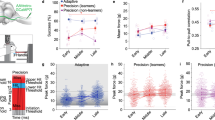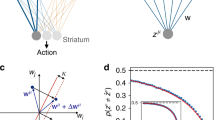Abstract
The learning of new skills is characterized by an initial phase of rapid improvement in performance and a phase of more gradual improvements as skills are automatized and performance asymptotes. Using in vivo striatal recordings, we observed region-specific changes in neural activity during the different phases of skill learning, with the associative or dorsomedial striatum being preferentially engaged early in training and the sensorimotor or dorsolateral striatum being engaged later in training. Ex vivo recordings from medium spiny striatal neurons in brain slices of trained mice revealed that the changes observed in vivo corresponded to regional- and training-specific changes in excitatory synaptic transmission in the striatum. Furthermore, the potentiation of glutamatergic transmission observed in dorsolateral striatum after extensive training was preferentially expressed in striatopallidal neurons, rather than striatonigral neurons. These findings demonstrate that region- and pathway-specific plasticity sculpts the circuits involved in the performance of the skill as it becomes automatized.
This is a preview of subscription content, access via your institution
Access options
Subscribe to this journal
Receive 12 print issues and online access
$209.00 per year
only $17.42 per issue
Buy this article
- Purchase on Springer Link
- Instant access to full article PDF
Prices may be subject to local taxes which are calculated during checkout





Similar content being viewed by others
References
Karni, A. et al. The acquisition of skilled motor performance: fast and slow experience-driven changes in primary motor cortex. Proc. Natl. Acad. Sci. USA 95, 861–868 (1998).
Miyachi, S., Hikosaka, O. & Lu, X. Differential activation of monkey striatal neurons in the early and late stages of procedural learning. Exp. Brain Res. 146, 122–126 (2002).
Miyachi, S., Hikosaka, O., Miyashita, K., Karadi, Z. & Rand, M.K. Differential roles of monkey striatum in learning of sequential hand movement. Exp. Brain Res. 115, 1–5 (1997).
Kargo, W.J. & Nitz, D.A. Improvements in the signal-to-noise ratio of motor cortex cells distinguish early versus late phases of motor skill learning. J. Neurosci. 24, 5560–5569 (2004).
Shiffrin, R.M. & Schneider, W. Controlled and automatic human information processing. II. Perceptual learning, automatic attending, and a general theory. Psychol. Rev. 84, 127–190 (1977).
Muellbacher, W. et al. Early consolidation in human primary motor cortex. Nature 415, 640–644 (2002).
Kleim, J.A. et al. Cortical synaptogenesis and motor map reorganization occur during late, but not early, phase of motor skill learning. J. Neurosci. 24, 628–633 (2004).
Jenkins, I.H., Brooks, D.J., Nixon, P.D., Frackowiak, R.S. & Passingham, R.E. Motor sequence learning: a study with positron emission tomography. J. Neurosci. 14, 3775–3790 (1994).
Doyon, J., Owen, A.M., Petrides, M., Sziklas, V. & Evans, A.C. Functional anatomy of visuomotor skill learning in human subjects examined with positron emission tomography. Eur. J. Neurosci. 8, 637–648 (1996).
Carelli, R.M., Wolske, M. & West, M.O. Loss of lever press–related firing of rat striatal forelimb neurons after repeated sessions in a lever pressing task. J. Neurosci. 17, 1804–1814 (1997).
Ungerleider, L.G., Doyon, J. & Karni, A. Imaging brain plasticity during motor skill learning. Neurobiol. Learn. Mem. 78, 553–564 (2002).
Brasted, P.J. & Wise, S.P. Comparison of learning-related neuronal activity in the dorsal premotor cortex and striatum. Eur. J. Neurosci. 19, 721–740 (2004).
Barnes, T.D., Kubota, Y., Hu, D., Jin, D.Z. & Graybiel, A.M. Activity of striatal neurons reflects dynamic encoding and recoding of procedural memories. Nature 437, 1158–1161 (2005).
Costa, R.M., Cohen, D. & Nicolelis, M.A. Differential corticostriatal plasticity during fast and slow motor skill learning in mice. Curr. Biol. 14, 1124–1134 (2004).
Voorn, P., Vanderschuren, L.J., Groenewegen, H.J., Robbins, T.W. & Pennartz, C.M. Putting a spin on the dorsal-ventral divide of the striatum. Trends Neurosci. 27, 468–474 (2004).
McGeorge, A.J. & Faull, R.L. The organization of the projection from the cerebral cortex to the striatum in the rat. Neuroscience 29, 503–537 (1989).
Yin, H.H., Ostlund, S.B., Knowlton, B.J. & Balleine, B.W. The role of the dorsomedial striatum in instrumental conditioning. Eur. J. Neurosci. 22, 513–523 (2005).
Yin, H.H., Knowlton, B.J. & Balleine, B.W. Lesions of dorsolateral striatum preserve outcome expectancy, but disrupt habit formation in instrumental learning. Eur. J. Neurosci. 19, 181–189 (2004).
Luft, A.R. & Buitrago, M.M. Stages of motor skill learning. Mol. Neurobiol. 32, 205–216 (2005).
Calabresi, P., Maj, R., Pisani, A., Mercuri, N.B. & Bernardi, G. Long-term synaptic depression in the striatum: physiological and pharmacological characterization. J. Neurosci. 12, 4224–4233 (1992).
Lovinger, D.M., Tyler, E.C. & Merritt, A. Short- and long-term synaptic depression in rat neostriatum. J. Neurophysiol. 70, 1937–1949 (1993).
Rioult-Pedotti, M.S., Friedman, D. & Donoghue, J.P. Learning-induced LTP in neocortex. Science 290, 533–536 (2000).
Gerfen, C.R. et al. D1 and D2 dopamine receptor-regulated gene expression of striatonigral and striatopallidal neurons. Science 250, 1429–1432 (1990).
Kreitzer, A.C. & Malenka, R.C. Endocannabinoid-mediated rescue of striatal LTD and motor deficits in Parkinson's disease models. Nature 445, 643–647 (2007).
Shen, W. et al. Cholinergic modulation of Kir2 channels selectively elevates dendritic excitability in striatopallidal neurons. Nat. Neurosci. 10, 1458–1466 (2007).
Shen, W., Flajolet, M., Greengard, P. & Surmeier, D.J. Dichotomous dopaminergic control of striatal synaptic plasticity. Science 321, 848–851 (2008).
Kerr, J.N. & Wickens, J.R. Dopamine D-1/D-5 receptor activation is required for long-term potentiation in the rat neostriatum in vitro. J. Neurophysiol. 85, 117–124 (2001).
Savasta, M., Dubois, A. & Scatton, B. Autoradiographic localization of D1 dopamine receptors in the rat brain with [3H]SCH 23390. Brain Res. 375, 291–301 (1986).
Joyce, J.N., Loeschen, S.K. & Marshall, J.F. Dopamine D-2 receptors in rat caudate-putamen: the lateral to medial gradient does not correspond to dopaminergic innervation. Brain Res. 338, 209–218 (1985).
Reynolds, J.N., Hyland, B.I. & Wickens, J.R. A cellular mechanism of reward-related learning. Nature 413, 67–70 (2001).
Dang, M.T. et al. Disrupted motor learning and long-term synaptic plasticity in mice lacking NMDAR1 in the striatum. Proc. Natl. Acad. Sci. USA 103, 15254–15259 (2006).
Carrillo-Reid, L. et al. Encoding network states by striatal cell assemblies. J. Neurophysiol. 99, 1435–1450 (2008).
Kasanetz, F., Riquelme, L.A., Della-Maggiore, V., O'Donnell, P. & Murer, M.G. Functional integration across a gradient of corticostriatal channels controls UP state transitions in the dorsal striatum. Proc. Natl. Acad. Sci. USA 105, 8124–8129 (2008).
Yin, H.H. & Knowlton, B.J. The role of the basal ganglia in habit formation. Nat. Rev. Neurosci. 7, 464–476 (2006).
Belin, D. & Everitt, B.J. Cocaine seeking habits depend upon dopamine-dependent serial connectivity linking the ventral with the dorsal striatum. Neuron 57, 432–441 (2008).
Takahashi, Y., Roesch, M.R., Stalnaker, T.A. & Schoenbaum, G. Cocaine exposure shifts the balance of associative encoding from ventral to dorsolateral striatum. Front. Integr. Neurosci. 1, 11 (2007).
Yin, H.H., Knowlton, B.J. & Balleine, B.W. Inactivation of dorsolateral striatum enhances sensitivity to changes in the action-outcome contingency in instrumental conditioning. Behav. Brain Res. 166, 189–196 (2006).
Hilario, M.R.F., Clouse, E., Yin, H.H. & Costa, R.M. Endocannabinoid signaling is critical for habit formation. Front. Integr. Neurosci. 1, 6 (2007).
Wickens, J.R., Budd, C.S., Hyland, B.I. & Arbuthnott, G.W. Striatal contributions to reward and decision making: making sense of regional variations in a reiterated processing matrix. Ann. NY Acad. Sci. 1104, 192–212 (2007).
Jedynak, J.P., Uslaner, J.M., Esteban, J.A. & Robinson, T.E. Methamphetamine-induced structural plasticity in the dorsal striatum. Eur. J. Neurosci. 25, 847–853 (2007).
Flajolet, M. et al. FGF acts as a co-transmitter through adenosine A(2A) receptor to regulate synaptic plasticity. Nat. Neurosci. 11, 1402–1409 (2008).
Rebola, N., Lujan, R., Cunha, R.A. & Mulle, C. Adenosine A2A receptors are essential for long-term potentiation of NMDA-EPSCs at hippocampal mossy fiber synapses. Neuron 57, 121–134 (2008).
Choi, W.Y., Balsam, P.D. & Horvitz, J.C. Extended habit training reduces dopamine mediation of appetitive response expression. J. Neurosci. 25, 6729–6733 (2005).
Richfield, E.K., Penney, J.B. & Young, A.B. Anatomical and affinity state comparisons between dopamine D1 and D2 receptors in the rat central nervous system. Neuroscience 30, 767–777 (1989).
Ljungberg, T., Apicella, P. & Schultz, W. Responses of monkey dopamine neurons during learning of behavioral reactions. J. Neurophysiol. 67, 145–163 (1992).
Taverna, S., Ilijic, E. & Surmeier, D.J. Recurrent collateral connections of striatal medium spiny neurons are disrupted in models of Parkinson's disease. J. Neurosci. 28, 5504–5512 (2008).
Martin, J.P. The Basal Ganglia and Posture (Pitman Medical, London, 1967).
Briand, K.A., Strallow, D., Hening, W., Poizner, H. & Sereno, A.B. Control of voluntary and reflexive saccades in Parkinson's disease. Exp. Brain Res. 129, 38–48 (1999).
Costa, R.M. et al. Rapid alterations in corticostriatal ensemble coordination during acute dopamine-dependent motor dysfunction. Neuron 52, 359–369 (2006).
Gerdeman, G.L., Ronesi, J. & Lovinger, D.M. Postsynaptic endocannabinoid release is critical to long-term depression in the striatum. Nat. Neurosci. 5, 446–451 (2002).
Acknowledgements
We thank T. Gremel and X. Jin for comments on the manuscript. This research was supported by the Division of Intramural Clinical and Basic Research of the National Institute on Alcohol Abuse and Alcoholism, US National Institutes of Health.
Author information
Authors and Affiliations
Contributions
H.H.Y. planned the experiments, conducted the behavioral experiments and in vivo and ex vivo recordings, performed data analyses and wrote the manuscript. S.P.M. performed ex vivo field recordings and data analyses. M.R.F.H. performed lesions, histology and behavioral experiments. E.C. and T.H. performed behavioral experiments; M.I.D. carried out immunohistochemistry; A.C.H. performed the dopamine binding experiments; D.M.L. contributed to experimental design and the writing of the manuscript; and R.M.C. planned and supervised experiments, contributed to behavioral experiments, histology and in vivo recordings, performed data analyses and wrote the manuscript.
Corresponding author
Supplementary information
Supplementary Text and Figures
Supplementary Figures 1–5, Supplementary Table 1 and Supplementary Methods (PDF 312 kb)
Supplementary Video 1
Naive mouse in rotarod 30 min after D1 + D2 dopamine receptor blockade. Note that the mouse is akinetic at the base of the rotarod, and once it is placed on the rotarod, it immediately falls. Reflexes are unaffected. (MPG 1818 kb)
Supplementary Video 2
Overtrained mouse 30 min after D1 + D2 dopamine receptor blockade. Note that the mouse is akinetic at the base of the rotarod, and once it is placed in the rotarod, it runs on the rod. (MPG 1962 kb)
Rights and permissions
About this article
Cite this article
Yin, H., Mulcare, S., Hilário, M. et al. Dynamic reorganization of striatal circuits during the acquisition and consolidation of a skill. Nat Neurosci 12, 333–341 (2009). https://doi.org/10.1038/nn.2261
Received:
Accepted:
Published:
Issue Date:
DOI: https://doi.org/10.1038/nn.2261
This article is cited by
-
Striatal dopamine neurotransmission is altered in age- and region-specific manner in a Parkinson’s disease transgenic mouse
Scientific Reports (2024)
-
Early excitatory-inhibitory cortical modifications following skill learning are associated with motor memory consolidation and plasticity overnight
Nature Communications (2024)
-
Sex differences in learning and performing the Go/NoGo tasks
Biology of Sex Differences (2023)
-
Striatonigral direct pathway 2-arachidonoylglycerol contributes to ethanol effects on synaptic transmission and behavior
Neuropsychopharmacology (2023)
-
Aberrations in temporal dynamics of cognitive processing induced by Parkinson’s disease and Levodopa
Scientific Reports (2023)



